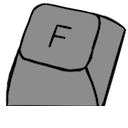| Both sides previous revisionPrevious revisionNext revision | Previous revision |
| keyboard:televideo_995-65 [12 Apr 2024 15:12] – [Gallery] tobleh | keyboard:televideo_995-65 [02 Oct 2024 08:15] (current) – [Description] pandrew |
|---|
| The terminal came with three different standard keyboard layouts - an "AT" keyboard, an "ASCII" keyboard, and a "DEC Style VT-320" keyboard. ((Televideo (Dec. 1994), retrieved from Bitsavers - [[http://bitsavers.org/pdf/televideo/995/Televideo_995-65_Users_Guide.pdf|Televideo 995-65 User's Guide]])), along with the AT and DEC style keyboards advertised as having layouts for US English, UK English, German, French, Spanish, Italian, Danish, and Swedish. ((Televideo (Oct. 1994), retrieved from Bitsavers - [[http://bitsavers.org/pdf/televideo/995/995-65-Specs.pdf|Televideo 995-65 Specs]])) | The terminal came with three different standard keyboard layouts - an "AT" keyboard, an "ASCII" keyboard, and a "DEC Style VT-320" keyboard. ((Televideo (Dec. 1994), retrieved from Bitsavers - [[http://bitsavers.org/pdf/televideo/995/Televideo_995-65_Users_Guide.pdf|Televideo 995-65 User's Guide]])), along with the AT and DEC style keyboards advertised as having layouts for US English, UK English, German, French, Spanish, Italian, Danish, and Swedish. ((Televideo (Oct. 1994), retrieved from Bitsavers - [[http://bitsavers.org/pdf/televideo/995/995-65-Specs.pdf|Televideo 995-65 Specs]])) |
| |
| All keyboards made for the Televideo 995-65 presumably shared the same construction, switches, and a Mini-DIN-6 plug normally found on PS/2 keyboards; however, all documented examples of these keyboards use code set 3, ((Purdea Andrei [purdeaandrei] (Nov. 2021) "Add support for the DEC layout Televideo Linear Space Invader keyboards to ibmpc_usb" [Github pull request for tmk_keyboard]. - [[https://web.archive.org/web/20231217180922/https://github.com/tmk/tmk_keyboard/pull/711|Archived via archive.org.]])) a protocol incompatible with basic PS/2 to USB converters. | All keyboards made for the Televideo 995-65 presumably shared the same construction, switches, and a Mini-DIN-6 plug normally found on PS/2 keyboards; however, all documented examples of these keyboards support non-standard versions of code sets 1, 2, and 3. The keyboard starts up in code set 1 by default, but using PS/2 protocol. Converter solutions such as TMK, and others based on TMK choose to use code set 3 because it shares most similarities with other code set 3 keyboards, and requires the least amount of custom code to support. ((Purdea Andrei [purdeaandrei] (Nov. 2021) "Add support for the DEC layout Televideo Linear Space Invader keyboards to ibmpc_usb" [Github pull request for tmk_keyboard]. - [[https://web.archive.org/web/20231217180922/https://github.com/tmk/tmk_keyboard/pull/711|Archived via archive.org.]])) the keyboard is incompatible with basic PS/2 to USB converters. |
| |
| All documented examples of these keyboards used [[terminology:linear|linear]] [[switch:hitek_series_725|Hi-Tek Series 725]] switches - with white sliders for main keys, and a neon-green slider for the space bar; and were fitted with thick PBT keycaps with [[terminology:dye_sublimation|dye-sublimated]] legends. | All documented examples of these keyboards used [[terminology:linear|linear]] [[switch:hitek_series_725|Hi-Tek Series 725]] switches - with white sliders for main keys, and a neon-green slider for the space bar; and were fitted with thick PBT keycaps with [[terminology:dye_sublimation|dye-sublimated]] legends. |
